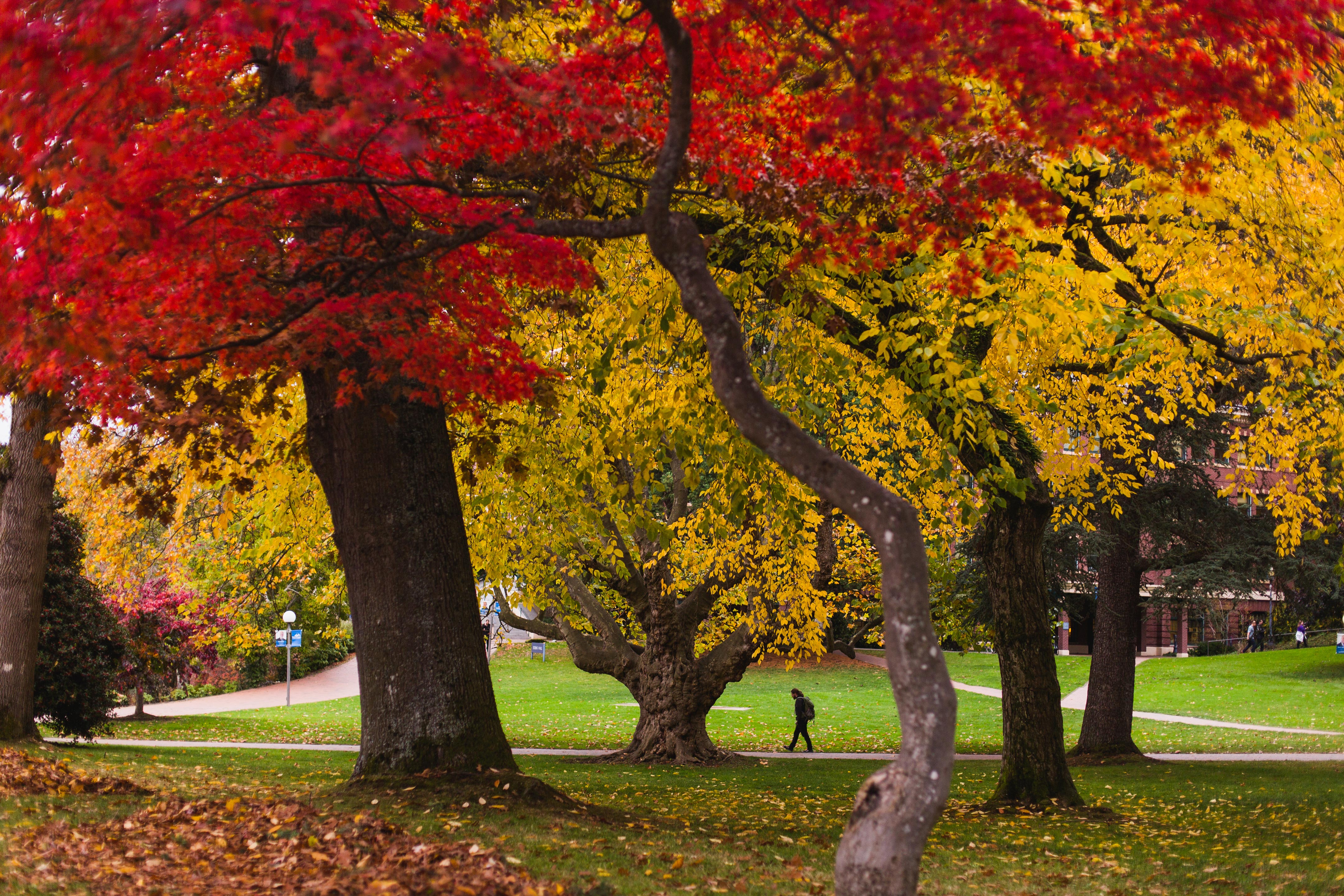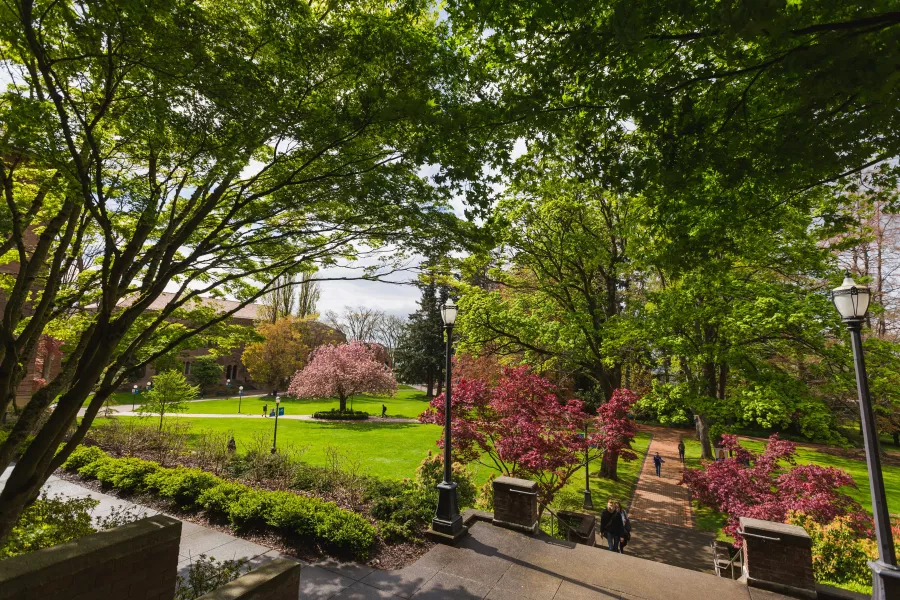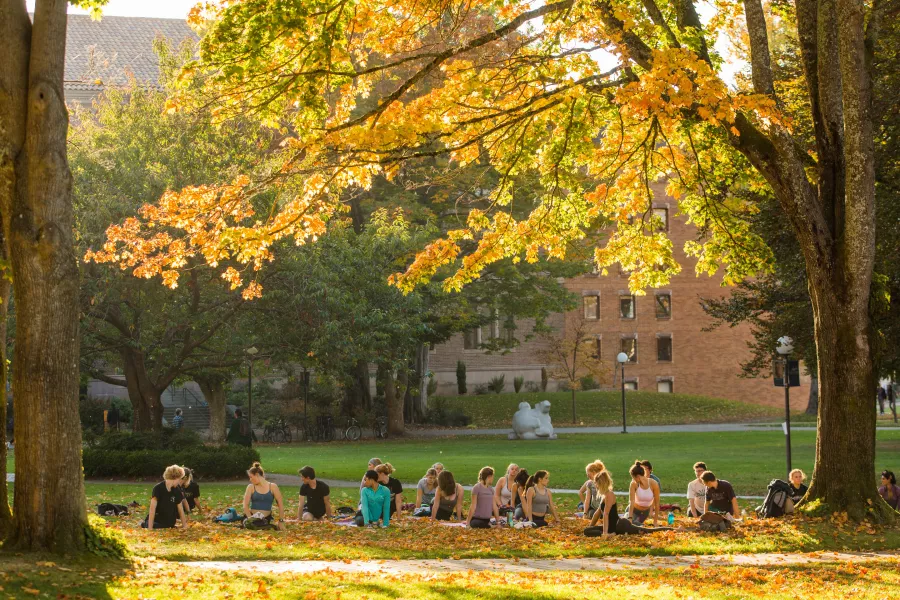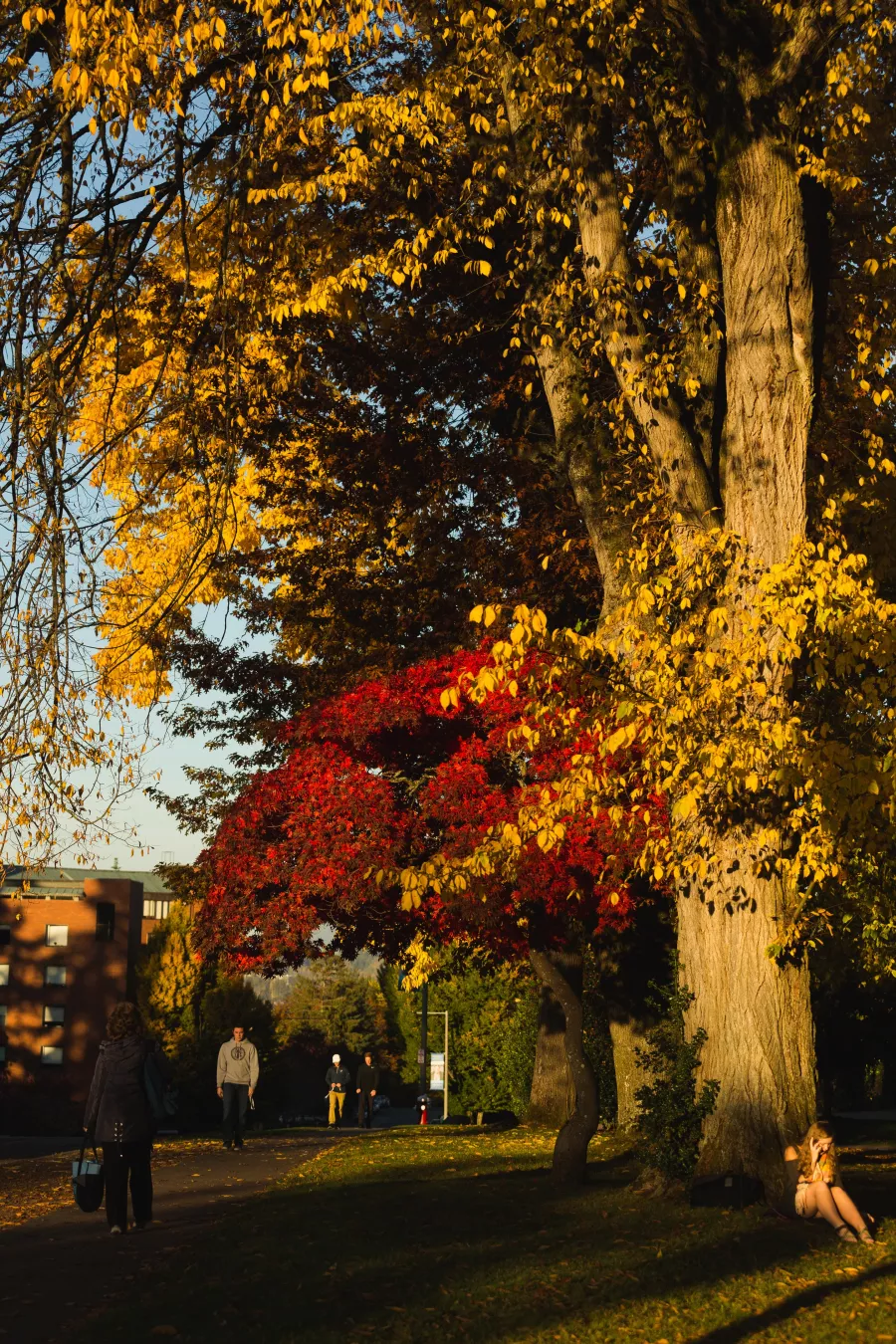On a campus tour stop near Old Main, right about when student guide Chase Jackson’s narrative turned to Western’s natural landscape—its beautiful grounds with adjacent Sehome Hill Arboretum as a backdrop—a prospective student peeled from the group to hug first one tree, then another.
To anyone who has walked Western’s pathways and red bricks, in the shadow of silent giants and century-old treasures, the question is obvious: Can you blame him?
Jackson could not. “That’s me on the inside,” says Jackson, a history/social studies major who keeps a lid on his own arbor love while maintaining tour-guide decorum. On sunny days, the senior will find a spot on the ground in the Bird Sanctuary, a knoll clustered with some of Western’s oldest trees, to study or eat. He lives on campus’s south end, which means he’ll sometimes take a wooded trail through “the Arb” to get to class. “Western’s campus has such calming, beautiful vibes,” he says. “It’s one of my favorite parts of the day, when my stress dissipates.”
From the younger, more orderly rows on the newer south campus to the aged beauties on the school’s original lawn, Western’s trees play a role in shaping the school’s identity and sense of place.
Of the thousands of trees on campus, many of them native Douglas firs, red cedars, spruces and maples, what sets Western’s apart is the oddballs. More than 70 different species have grown here, some planted, especially in the school’s early days from 1899 to the 1920s, like ingredients in a family recipe: a little bit of this, a little bit of that.
Leafy elder statesmen
In 2008, Myrl Beck, a retired Western geology professor, published an impressive tree tour guide highlighted by unusual-for-here specimens like the Camperdown Elm on the sanctuary’s northern side, a row of ginkgoes near the Ross Engineering Building, and the sycamore-related plane trees bordering Red Square, among others.
Beck admires trees at the University of Washington and other schools. But “they don’t seem to blend in with the whole campus décor like ours do,” he says. “Ours are part and parcel of the campus. If you took those trees away and put anything in there, campus would be seriously degraded in terms of aesthetic appeal.” He points to the huge, old plane tree on the Old Main lawn near High Street, one with giant branches going in all directions. “What would the campus be without that?”
When it comes to construction, Western’s culture now involves arborists along with architects. “It used to be when I first got here (in 2006) and a new building would be coming online, they wouldn’t even consider the trees,” says outdoor maintenance supervisor Gary Hodge. “They would just mow them down and off they’d go because they were in the way. Now we are involved in it from the get-go to try to figure out which trees we can salvage and what trees will need to go and what the best design is to assist with that.”
Two ongoing and upcoming construction projects, a new residence hall replacing Highland, and an interdisciplinary science building, will result in the loss of some trees. They’ll be mulched and used for salmon habitat restoration in local streams. And the same number of new trees will be planted on campus to replace the trees for future generations.
At the residence hall site, two ponderosa pines and one white pine, each about 80 feet tall, are getting special consideration. “We don’t have a lot of those on campus” of that size, Hodge says, “so I was putting a little bit more emphasis on really monitoring those trees, making sure that they stay as viable as possible during construction.”
These days, Hodge and Western lead gardener Heidi Zeretzke’s crew are waging war against time. The 100-year-old Norway maples lining Memory Walk into Old Main are deteriorating, pruned often of dying limbs. Several American elms that once populated the lawn have been cut down entirely, and Hodge and gardener Oskar Kollen are keeping an eye on the Bird Sanctuary’s white pines.
Five generations of Zeretzke’s family have attended Western, beginning with her great-grandfather in 1917. The 1982 graduate in visual communication thought of him often as she tended the trees around Old Main, wondering which “elder statesmen” might have offered him a shady spot to rest.
“I’m sure he never imagined that one day his great granddaughter would be the caretaker of those very trees,” Zeretzke says. “I like to think of him and all the future generations of my family that might have sat—or will sit—in the shade of those trees on a bright sunny day. Who knows? It might be my future great granddaughter taking care of them.”
Pretty and green and orangey
Once, there were hardly any trees at all. Old photos show the bare campus of the New Whatcom Normal School, Western’s predecessor, that opened to classes in 1899. Research tells of instructor Ida Agnes Baker, hired that year and appalled by devastation wrought by (Old) Main’s construction, she made it her mission to plant the campus back to life.
According to a 1996 paper written by Huxley student Cindy L. Carroll, ’96, B.S., environmental science, Baker worked with the school landscaper, often year-round, to plan and plant. Some of her work is almost certainly among those trees towering over us today, more than a century later: the Douglas firs of the Bird Sanctuary, a poplar near Wilson Library, maybe even that distinctive plane tree, likely campus’s oldest.
Some seven decades before Earth Day, Baker founded the school’s nature study and forestry departments. Baker was beloved by students, who dedicated the sanctuary in her name after she was killed by a streetcar in 1921 at age 61. The remnants of a bird bath inscribed with her name and the year still reside in the sanctuary, next to an old flagpole.
Baker was famous for placing bird houses in trees on campus, gathering students each Arbor Day for plantings, and packing empty cans to bring back seedlings from Mount Baker hikes. Returning from a 1915 sabattical spent traveling the country, Baker said she “saw many beautiful landscapes, but came back satisfied that there is no school with a location surpassing our own in beauty and no place where there is so much physical, intellectual and aesthetic pleasure in living as in our land of the pointed firs.”
When Rose Howe, ’17, B.A., economics/environmental studies, first visited campus during a summer camp for prospective students, she found campus a different world from home in northwestern Colorado. “It was one of those golden afternoons in August. The afternoon light just hits it right, it was pretty and green and orangey,” she says. “It just felt like a cool, outdoorsy spot to go to school.”
Next time you walk campus, look up. Western’s giant sequoia by Edens Hall, the so-called “Miller Tree,” is a 120-foot cone of beauty festooned each year with holiday lights. Check out the slender Fox River white birches near Wilson Library’s elevated walkway; the nearby Alaskan weeping cedars, Seussian in their shaggy, slope-shouldered drape.
Turns out, Western’s tree reputation is long held. Author Ella Higginson, the namesake of Higginson Hall along with her husband, became the state’s first poet laureate in 1931. Her house, just north of where Viking Union stands today, overlooked the trees of Old Main’s lawn. In one of the last of her 500 poems before her death in 1940, Higginson lamented what she’d have to leave behind “when I drift out the narrow straits into the midnight sea.” Not family or home or people, but trees. “I cannot take my hemlocks,” or her firs, birches or elms, Higginson wrote.
Luckily they’re still here for all of us, and available for hugs.



